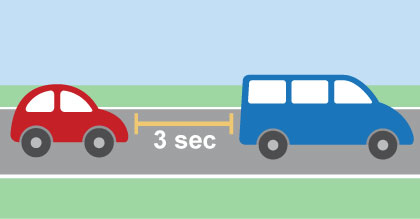 Good Weather – During daylight with good, dry roads and low traffic volume, you can ensure you’re a safe distance from the car ahead of you by following the “three-second rule.” The distance changes at different speeds.
Good Weather – During daylight with good, dry roads and low traffic volume, you can ensure you’re a safe distance from the car ahead of you by following the “three-second rule.” The distance changes at different speeds.
To determine the right following distance, first select a fixed object on the road ahead such as a sign, tree or overpass. When the vehicle ahead of you passes the object, slowly count “one one thousand, two one thousand, three one thousand.” If you reach the object before completing the count, you’re following too closely. Making sure there are three seconds between you and the car ahead gives you time and distance to respond to problems in the lane ahead of you.
Inclement Weather, Heavy Traffic, or Night-Time Driving – In heavy traffic, at night, or when weather conditions are not ideal (eg. light rain, light fog, light snow), double the three second rule to six seconds, for added safety.
Poor Weather – If the weather conditions are very poor, eg. heavy rain, heavy fog, or heavy snow, start by tripling the three second rule to nine seconds to determine a safe following distance.
Tailgating – Following a vehicle too closely is called ‘tailgating’. Tailgating is an agressive driving behaviour that is easily mistaken for road rage. Use the three-second rule to avoid tailgating. Most rear end collisions are caused by the vehicle in back following too closely. If someone is tailgating you, move to another lane or turn off the road as soon as possible and allow the tailgating vehicle to pass.
| Three-Second Rule | Safe Interval Should Be > | 3 seconds | 6 seconds | |
| Speed | Distance Traveled | For These Conditions > | Good | Marginal |
| 25 m.p.h. | 37 ft. per second | 111 ft. | 222 ft. | |
| 35 m.p.h. | 52 ft. per second | 166 ft. | 312 ft. | |
| 45 m.p.h. | 66 ft. per second | 198 ft. | 396 ft. | |
| 55 m.p.h. | 81 ft. per second | 243ft. | 486 ft. | |
| 65 m.p.h. | 96 ft. per second | 288 ft. | 576 ft. | |
| 75 m.p.h. | 111 ft. per second | 333 ft. | 666 ft. | |
| Safe Following Distance in Feet | ||||
